What if the smartest training partner you’ll ever have doesn’t wear a whistle, doesn’t spot your squats, and doesn’t need a gym?
Note: This article is for educational and informational purposes only. See full disclaimer at the end.
Artificial intelligence is quietly revolutionizing exercise science—not just for elite athletes, but for anyone who moves.
We’re living through the most dramatic transformation in exercise science since the invention of weights. It’s not a fairytale—it’s a hard pivot in how we understand and optimize movement itself.
The AI fitness market, valued at $9.8 billion in 2024, is projected to reach $46.1 billion by 2034, representing a 16.8% compound annual growth rate [8]. The numbers tell the story: this isn’t hype—it’s the new reality of exercise science.
Most people train harder to get better results. But what if improvement didn’t require more effort—but more intelligence?
That’s the real shift we’re living through: a world where your data doesn’t just get stored—it gets interpreted, learned from, and used to create a better version of you.
But here’s what makes this revolution different: AI doesn’t just track your workouts—it understands them. It recognizes patterns in your movement, predicts your recovery needs, and adapts your training in real-time based on thousands of variables your human trainer could never simultaneously monitor.
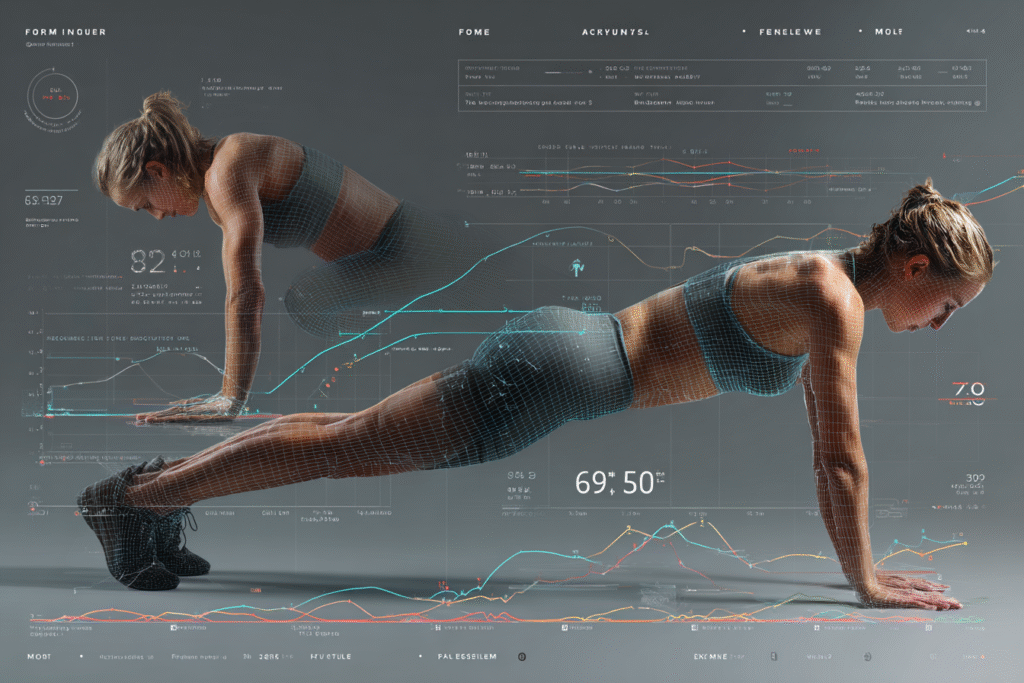
Whether you’re just starting your fitness journey or you’re an experienced athlete looking to break through plateaus, AI offers unprecedented opportunities to maximize your training efficiency, minimize injury risk, and achieve results faster than ever before.
Let’s explore how artificial intelligence is reshaping the future of exercise—and how you can harness these technologies regardless of your current fitness level.
So how exactly does AI go from passive observer to personalized performance coach?
From Counting Steps to Coaching You
While traditional fitness technology gave us step counters and heart rate monitors, AI has evolved from a mere passive tracker to an active partner.
AI gives us something fundamentally different: intelligence that understands the complexity of human movement and adaptation. Modern AI fitness systems don’t just collect data—they interpret it, learn from it, and use it to make increasingly sophisticated decisions about your training.
Research demonstrates that health and fitness applications incorporating AI-driven personalization have 50% higher retention rates compared to traditional apps [9]. This engagement difference stems from AI’s ability to create truly personalized experiences that adapt to individual progress, preferences, and physiological responses.
The Intelligence Behind the Technology
AI exercise optimization operates through several sophisticated technologies working in concert. Let’s break down the core technologies powering this revolution—and how they work behind the scenes to upgrade your training.
Computer Vision and Movement Analysis
AI-powered cameras and sensors can analyze your movement patterns with precision that exceeds human observation. These systems track joint angles, movement speed, force application, and biomechanical efficiency in real-time, detecting form deviations as small as 5-degree variations in joint positioning [10].
Using advanced computer vision technology, AI can ensure proper exercise form by analyzing posture alignment, detecting deviations from optimal movement patterns, and providing instant corrective feedback.
While computer vision captures what you’re doing, machine learning algorithms determine what you should do next.
Machine Learning Adaptation
AI algorithms continuously learn from your performance data, adjusting training variables like intensity, volume, and exercise selection based on your progress patterns.
Research shows that machine learning algorithms can optimize training programs with 92.3% accuracy by analyzing factors including strength, endurance, agility, heart rate variability, and recovery metrics [1].
This accuracy applies specifically to predicting optimal training loads and exercise selection based on individual performance patterns and physiological responses.
Predictive Analytics
Perhaps most importantly, AI can predict outcomes—identifying injury risk factors, forecasting recovery needs, and determining optimal training loads before problems occur.
Studies indicate that AI systems can predict injury risk with up to 79% accuracy by analyzing factors including joint strength, postural stability, flexibility, and previous injury history [2].
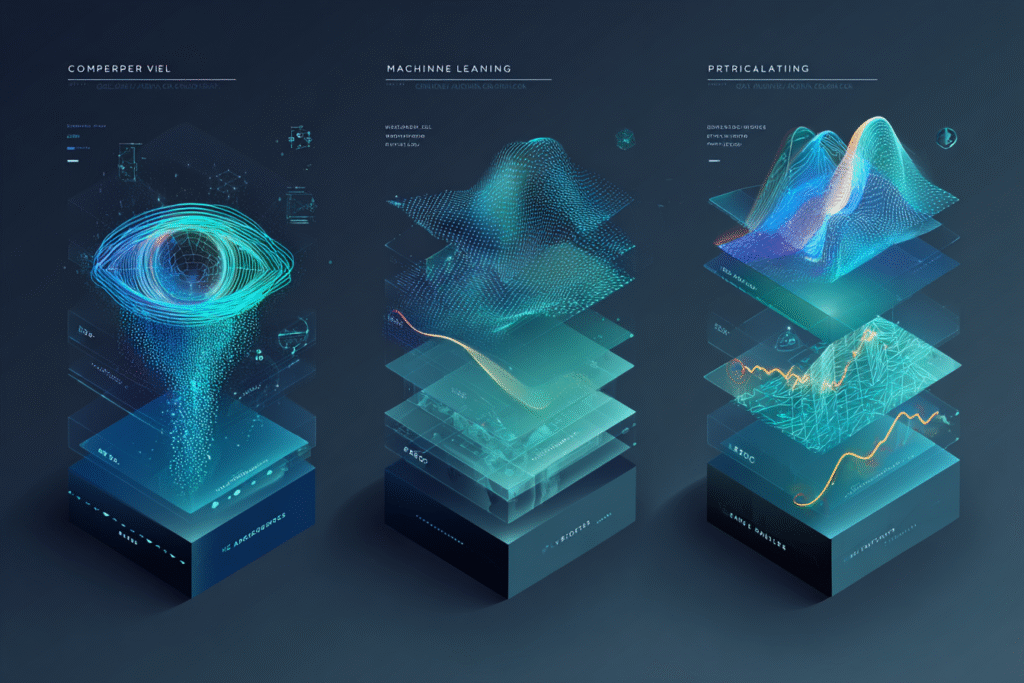
How AI Is Reshaping Every Corner of the Gym
From your living room to Olympic facilities, AI is reshaping the way we train. But it’s not just what we do—it’s how, when, and why we do it that’s being redefined.
Your Digital Coach Has Arrived
AI-powered virtual trainers represent one of the most accessible applications of exercise AI. These systems combine computer vision, natural language processing, and machine learning to provide personalized coaching experiences that rival human trainers.
Real-Time Form Correction: Advanced AI trainers use smartphone cameras or dedicated sensors to analyze your exercise form during each repetition. They can detect subtle deviations in movement patterns and provide immediate corrective feedback. For example, AI systems can analyze squat depth, knee tracking, and back alignment simultaneously, ensuring proper form while reducing injury risk [11].
Adaptive Workout Design: AI trainers create personalized workout plans that evolve based on your progress, preferences, and goals. Unlike static programs, these systems continuously adjust exercise selection, intensity, and volume based on your performance patterns. Research indicates that AI-powered personalized training programs can improve exercise adherence by up to 40% compared to generic routines [12].
Progress Pattern Recognition: AI can identify subtle patterns in your performance that indicate adaptation, fatigue, or plateau. This allows for precise adjustments to training variables before performance stagnates or overtraining occurs.
Smart Equipment Integration: When Machines Think
The integration of AI into exercise equipment is transforming both home and commercial gym environments. Smart equipment doesn’t just track your workout—it participates in optimizing it.
Intelligent Resistance Adjustment: AI-powered strength equipment can automatically adjust resistance based on your fatigue level, strength curve, and training goals. Systems like Tonal use electromagnetic resistance that adapts in real-time, providing optimal challenge throughout each repetition [13].
Form Analysis and Correction: Smart equipment with built-in cameras and sensors can analyze your movement patterns and provide immediate feedback. These systems can detect compensatory movement patterns, asymmetries, and deviations from optimal form, helping prevent injury while maximizing exercise effectiveness [14].
Predictive Maintenance and Equipment Optimization: AI systems in commercial gyms can predict equipment maintenance needs, optimize usage patterns, and reduce downtime. This ensures consistent equipment availability while improving the overall training environment [15].
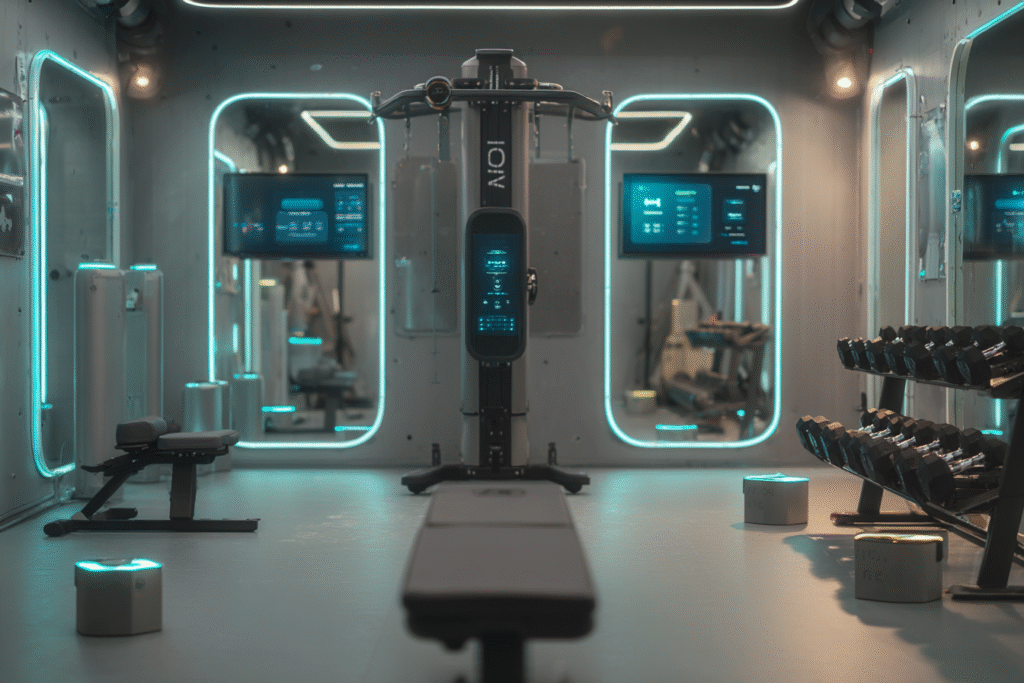
Injury Prevention: AI as Your Guardian
One of AI’s most valuable applications in exercise lies in injury prevention. By analyzing movement patterns, training loads, and physiological markers, AI can identify risk factors and implement preventive strategies before injuries occur.
Movement Pattern Analysis: AI systems use computer vision and machine learning to assess movement patterns and identify deviations that indicate increased injury risk. For athletes in sports like basketball, soccer, or running, subtle changes in gait, balance, or movement quality can predict stress injuries before they manifest [3].
Load Management and Recovery Optimization: AI algorithms analyze training data from wearables and equipment to optimize training loads and recovery protocols. These systems can predict when an athlete is at increased risk of overuse injury and recommend appropriate load modifications [6].
Real-Time Risk Assessment: During training sessions, AI can provide immediate alerts when movement patterns or physiological markers indicate elevated injury risk. This allows for immediate intervention, such as form correction, load reduction, or session termination [7].
Find Your Level: AI Tools for Every Budget and Body
AI exercise optimization offers solutions for every fitness level and budget. Understanding the different implementation levels helps you choose the approach that best fits your current situation and goals.
Level 1: Smartphone-Based AI (Beginner-Friendly)
Smartphone-based AI fitness apps represent the most accessible entry point into AI exercise optimization. These apps use your phone’s camera and sensors to provide AI-powered coaching and analysis.
- Cost: $0-50/month
- Requirements: Smartphone with camera
- Best For: Beginners to intermediate exercisers, home workouts, budget-conscious users
Key Capabilities:
- Exercise form analysis using computer vision
- Personalized workout generation based on goals and available equipment
- Progress tracking with AI-powered insights
- Voice-guided coaching with real-time adjustments
Example Applications:
- FitBod: Creates adaptive workout plans using AI analysis of your goals, available equipment, and progress patterns
- Kemptai: Provides AI-driven form analysis using your smartphone camera, offering real-time feedback on exercise technique
- Freeletics: Uses AI to evolve workout content based on user progress and performance patterns
Implementation Strategy: Start with one comprehensive app that covers your primary fitness goals. Use the AI form analysis features consistently to build proper movement patterns, then gradually incorporate the adaptive programming features as you progress.
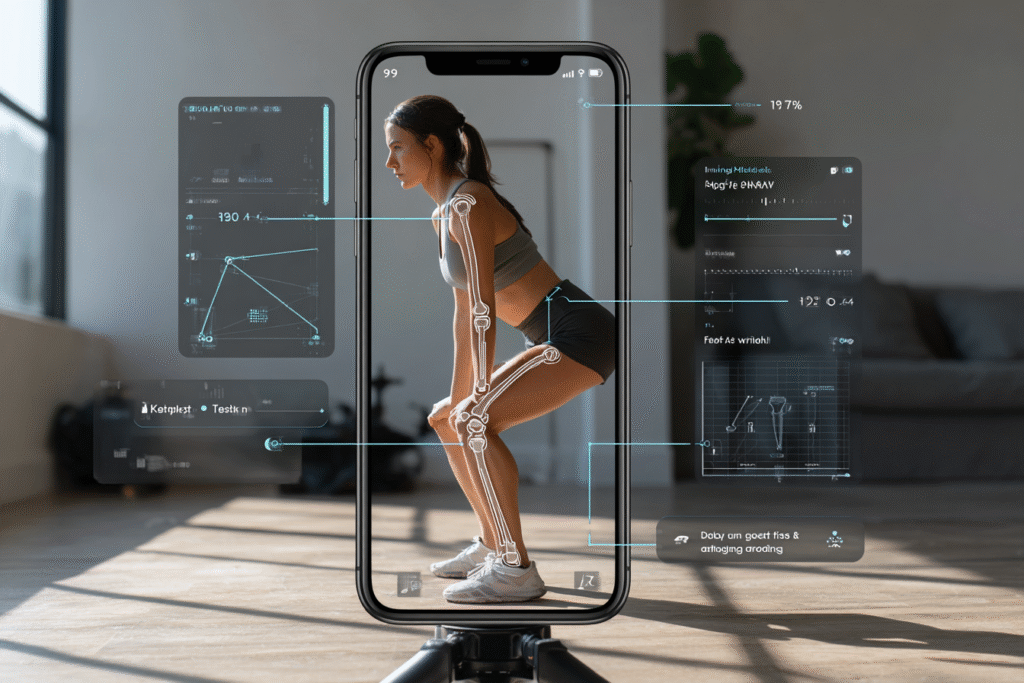
Level 2: Wearable-Enhanced AI (Intermediate)
Wearable-enhanced AI combines smartphone capabilities with dedicated fitness sensors to provide more comprehensive analysis and recommendations.
- Cost: $200-800 initial investment, $10-30/month for services
- Requirements: Fitness wearables, smartphone, basic smart equipment
- Best For: Regular exercisers, data-driven individuals, those seeking optimization
Key Capabilities:
- Continuous physiological monitoring (heart rate, HRV, sleep, recovery)
- Advanced workout analysis combining movement and physiological data
- Predictive recommendations for training and recovery
- Integration with smart gym equipment
Example Technologies:
- Whoop: Analyzes physiological data to provide insights into recovery, strain, and sleep quality, offering personalized training recommendations
- Fitbit/Garmin Integration: Advanced fitness trackers that use AI to optimize workout recommendations based on recovery status and fitness trends
- Smart Home Gym Equipment: Magic AI Mirror, Tonal, or Tempo systems that combine AI coaching with equipment integration
Implementation Strategy: Begin with a comprehensive wearable that matches your primary activities (Whoop for overall optimization, Garmin for endurance sports, etc.). Use the recovery and readiness data to inform your training decisions, then gradually incorporate smart equipment as budget allows.
Level 3: Professional AI Optimization (Advanced)
Professional-level AI optimization combines multiple technologies to provide comprehensive analysis and optimization across all aspects of training and recovery.
- Cost: $1,000-10,000+ initial investment, $100-500/month for services
- Requirements: Professional-grade equipment, multiple sensors, possibly dedicated space
- Best For: Serious athletes, professionals, those with specific performance goals
Key Capabilities:
- Multi-sensor movement analysis with sub-millimeter precision
- Comprehensive physiological monitoring including blood markers, hormone levels
- Advanced predictive modeling for performance and injury risk
- Integration with professional coaching and sports science support
Example Technologies:
- Motion Capture Systems: Professional-grade movement analysis used by sports teams and elite athletes
- Catapult Vector: GPS and accelerometer systems used by professional soccer teams worldwide for load monitoring and injury prevention
- Force Plate Analysis: Ground reaction force measurement for detailed biomechanical analysis
- Continuous Glucose Monitoring: Integration with AI for metabolic optimization and energy management
Implementation Strategy: Work with qualified sports scientists or performance coaches to design a comprehensive system that addresses your specific performance goals. Implement technologies gradually, ensuring proper interpretation and application of the data generated.
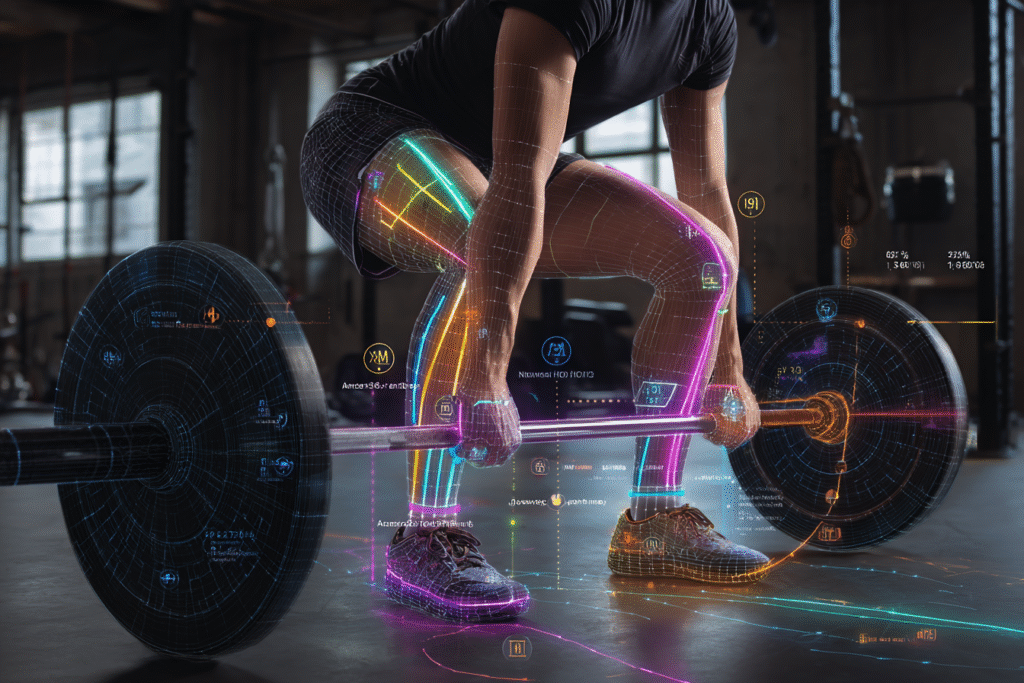
AI Coaching and Real-Time Feedback
The real breakthrough isn’t just tracking what you did—it’s coaching you while you’re doing it. In real-time. With intelligence that never blinks.
AI coaching systems don’t just react—they learn while you move.
The evolution from passive fitness tracking to active AI coaching represents a fundamental shift in how we approach exercise optimization. Modern AI coaching systems provide real-time feedback that rivals or exceeds human trainer capabilities in many areas.
Real-Time Movement Analysis
AI coaching systems excel at providing immediate feedback on movement quality and exercise execution. Using computer vision and machine learning algorithms, these systems can:
Analyze Complex Movement Patterns: AI can simultaneously monitor multiple joints and movement planes, detecting subtle deviations that might escape human observation. For compound movements like squats or deadlifts, AI can monitor ankle mobility, knee tracking, hip hinge pattern, spinal alignment, and shoulder position simultaneously [4].
Provide Immediate Corrective Feedback: Rather than waiting until after a set to provide feedback, AI systems can offer real-time cues for movement correction. This immediate feedback loop accelerates learning and helps establish proper movement patterns more efficiently [5].
Track Progress Over Time: AI coaching systems maintain detailed records of movement quality over time, allowing for identification of improvement trends, developing compensations, or regression patterns that require attention.
This real-time analysis becomes the foundation for AI’s most powerful capability: adapting your entire program based on what it observes.
Adaptive Programming
AI coaching systems excel at program adaptation based on real-time performance and long-term progress patterns.
Dynamic Load Adjustment: AI can adjust training loads during workouts based on performance indicators like bar speed, power output, or movement quality. If the system detects fatigue-related performance decline, it can recommend load reductions or exercise modifications.
Exercise Selection Optimization: Based on your movement patterns, strengths, weaknesses, and goals, AI can optimize exercise selection for maximum effectiveness. The system learns which exercises produce the best responses for your individual physiology and preferences.
But the smartest programming adjustments happen when AI considers not just your current performance, but your body’s readiness for what comes next.
Recovery Integration: AI coaching systems can integrate recovery data from wearables and other sources to adjust training intensity and volume. This ensures training sessions align with your body’s readiness to perform and adapt.
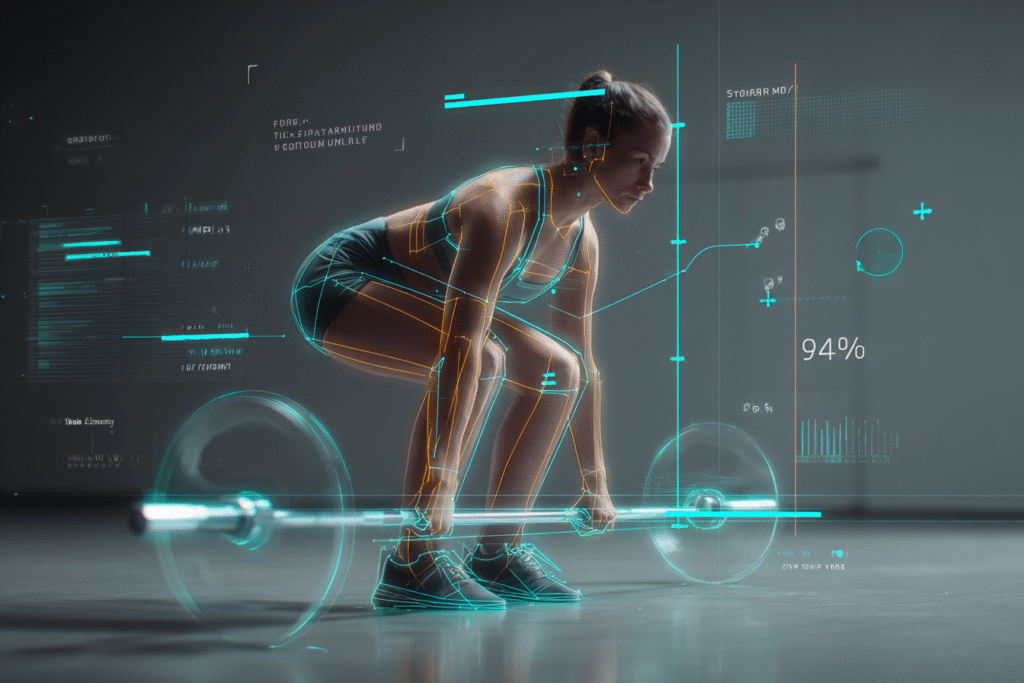
When AI Sees What You Don’t
One of AI’s most powerful applications in exercise lies in its predictive capabilities. By analyzing vast amounts of data, AI can forecast performance trends, identify optimization opportunities, and predict potential issues before they become problems.
Performance Prediction and Plateau Prevention
AI systems can analyze your training data to predict performance trends and identify when plateaus are likely to occur.
Progress Forecasting: By analyzing your current performance trends, training history, and physiological responses, AI can predict future performance outcomes and identify the training modifications needed to continue progress.
Plateau Identification: AI can detect early signs of adaptation plateau before they become apparent through traditional metrics. This allows for proactive program modifications to maintain progress momentum.
Optimal Training Load Prediction: AI algorithms can determine the precise training loads needed to spark adaptation without tipping into fatigue or injury risk. That balance between stimulus and recovery is the key to long-term progress.
Recovery Optimization
AI excels at analyzing recovery patterns and optimizing recovery protocols for individual athletes.
Sleep Quality Analysis: AI can analyze sleep data from wearables to provide detailed insights into sleep quality, recovery effectiveness, and readiness for training. Advanced systems can correlate sleep patterns with training performance to optimize both.
Heart Rate Variability Interpretation: AI systems can analyze HRV patterns to assess autonomic nervous system status and overall recovery. This provides precise guidance on training intensity and recovery needs.
Nutrition and Hydration Optimization: By integrating training data with nutritional intake and hydration status, AI can provide personalized recommendations for optimal fueling and recovery.

Technology Integration and Smart Equipment
The integration of AI with exercise equipment is creating unprecedented opportunities for training optimization. From smart home gyms to professional facilities, AI-enhanced equipment is changing how we approach strength training, cardio, and recovery.
Smart Strength Training
AI-powered strength training equipment offers several advantages over traditional weights:
Electromagnetic Resistance Systems: Equipment like Tonal uses electromagnetic resistance that can be precisely controlled by AI algorithms. This allows for variable resistance throughout the range of motion, optimizing force curves for maximum muscle activation.
Real-Time Form Analysis: Smart strength equipment with integrated cameras can analyze form during each repetition, providing immediate feedback and automatically adjusting resistance if form degrades.
Personalized Resistance Curves: AI can create individualized resistance curves based on your strength profile, ensuring optimal muscle activation throughout each exercise’s range of motion.
Cardiovascular Training Innovation
AI is transforming cardiovascular training through adaptive programming and real-time optimization:
Adaptive Interval Training: AI can adjust interval intensities and durations in real-time based on your physiological responses, ensuring optimal training stimulus while preventing overexertion.
Heart Rate Zone Optimization: Rather than using generic heart rate zones, AI can determine your individual zones based on your physiological responses and adapt them over time as your fitness improves.
Environmental Adaptation: AI can adjust training recommendations based on environmental factors like temperature, humidity, and altitude, ensuring optimal performance regardless of conditions.
Recovery Technology Integration
AI-enhanced recovery technologies are becoming increasingly sophisticated:
Smart Recovery Devices: Devices like pneumatic compression systems and percussion massage tools can be controlled by AI algorithms that determine optimal pressure, duration, and frequency based on your training load and recovery needs.
Environmental Control: AI can optimize your recovery environment by controlling factors like temperature, humidity, and lighting to promote optimal sleep and recovery.
Recovery Protocol Optimization: AI can analyze the effectiveness of different recovery modalities for your individual physiology and recommend the optimal combination of interventions.
How to Build Your Personal AI Fitness Ecosystem
Successfully implementing AI exercise optimization requires a strategic approach that considers your current fitness level, goals, budget, and technical comfort. Here’s how to build an effective AI-enhanced training system regardless of your starting point.
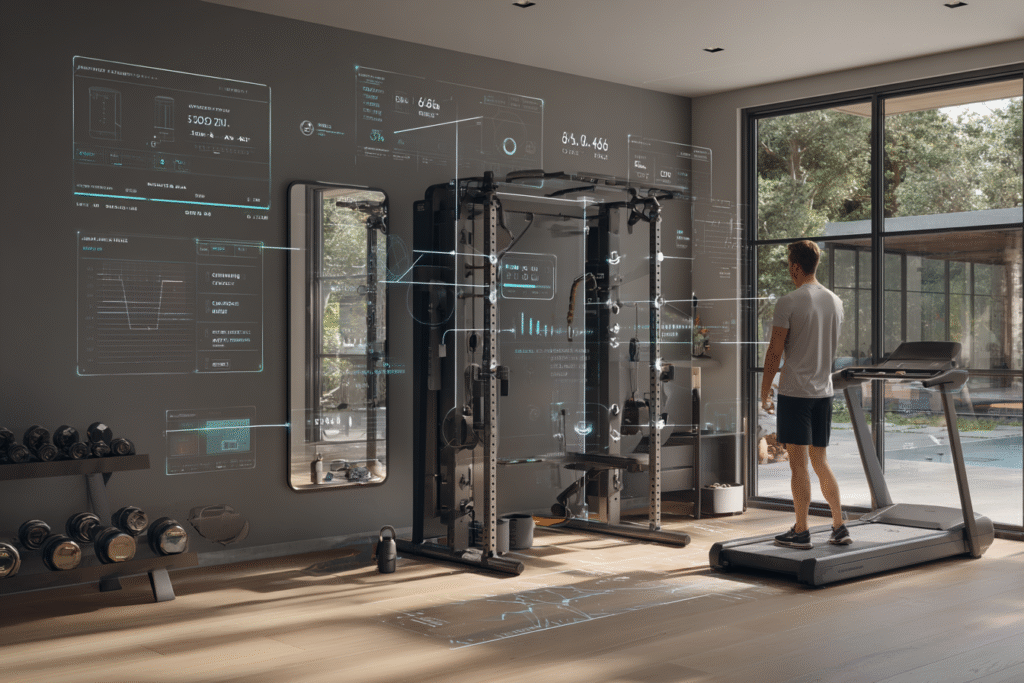
Getting Started: The Foundation Phase
Step 1: Establish Your Baseline Before implementing AI technologies, establish clear baseline measurements of your current fitness level, movement quality, and performance metrics. This provides the foundation for AI systems to build upon and measure progress against.
Step 2: Choose Your Primary Platform Select one comprehensive AI fitness platform that aligns with your primary goals rather than trying to use multiple systems simultaneously. Master this platform’s capabilities before adding additional technologies.
Step 3: Focus on Form and Movement Quality Use AI form analysis tools consistently to establish proper movement patterns. This foundation is crucial for all future training optimization and injury prevention.
Progression Strategy: Building Your AI Ecosystem
Phase 1: Smartphone-Based Foundation (Months 1-3)
- Implement one comprehensive AI fitness app
- Use form analysis features consistently
- Track basic progress metrics
- Establish consistent training habits
Phase 2: Wearable Integration (Months 3-6)
- Add fitness wearable for physiological monitoring
- Begin using recovery data to inform training decisions
- Integrate sleep and stress monitoring
- Start using predictive recommendations
Phase 3: Equipment Enhancement (Months 6-12)
- Introduce smart equipment based on training focus
- Integrate multiple data sources for comprehensive analysis
- Begin using advanced features like adaptive programming
- Consider professional guidance for complex implementations
Data Integration and Interpretation
Centralized Data Management: Use platforms that can integrate data from multiple sources to provide comprehensive analysis. This prevents data silos and ensures AI systems have access to complete information for optimal recommendations.
Focus on Actionable Insights: Prioritize AI systems that provide clear, actionable recommendations rather than just data display. The goal is to improve your training, not just track more metrics.
Regular Review and Adjustment: Schedule regular reviews of your AI-generated recommendations and their effectiveness. AI systems improve with feedback, so providing input on recommendation quality helps optimize future suggestions.
Where AI Still Falls Short
While AI exercise optimization offers tremendous potential, understanding its current limitations and challenges is essential for realistic expectations and effective implementation.
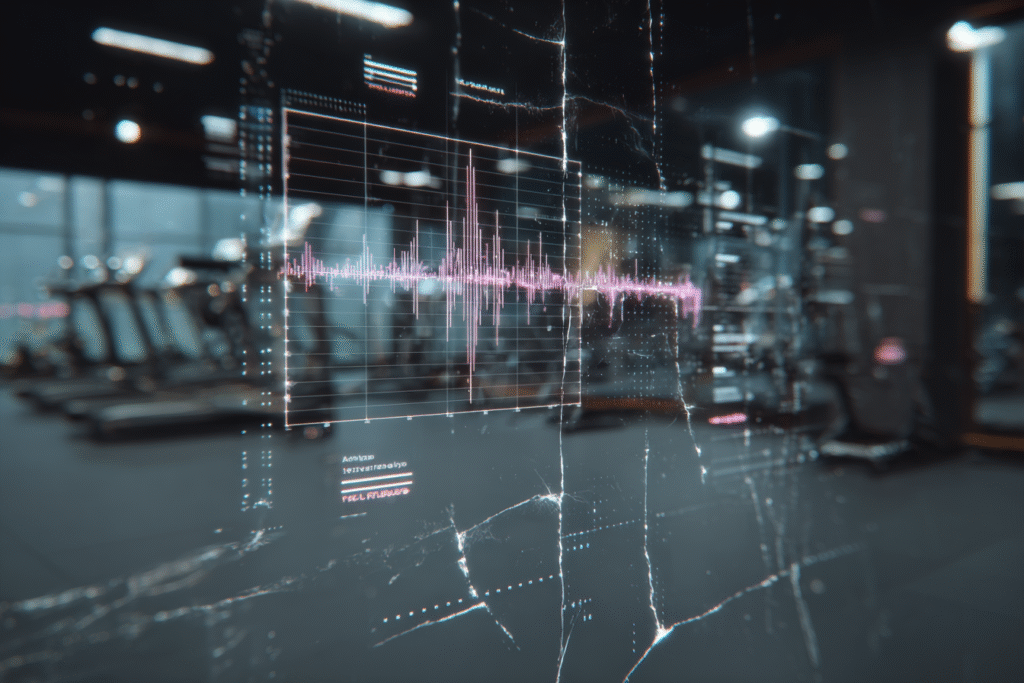
Technical Limitations
Data Quality Dependencies: AI systems are only as good as the data they receive. Poor sensor placement, inconsistent usage, or environmental interference can lead to inaccurate recommendations.
Individual Variation: Current AI systems may not account for unique individual factors like genetic variations, medical conditions, or personal preferences that significantly impact training responses.
Integration Complexity: Combining multiple AI systems and data sources can create technical challenges and compatibility issues that require ongoing management.
Accuracy and Reliability Concerns
Movement Analysis Limitations: While AI excels at analyzing movement patterns, it may miss subtle biomechanical factors that experienced human coaches would detect.
Context Understanding: AI systems may lack the contextual understanding that human trainers provide, such as recognizing when someone is dealing with external stressors that affect training capacity.
Predictive Accuracy: While AI can predict many outcomes with high accuracy, individual responses to training can be highly variable, and predictions should be viewed as guidance rather than guarantees.
Maintaining Human Element
Coach-Athlete Relationship: AI cannot replicate the motivational, emotional, and psychological support that human coaches provide. The most effective implementations combine AI optimization with human guidance.
Personalization Depth: Human trainers can adapt to complex individual needs, preferences, and circumstances in ways that current AI systems cannot fully replicate.
Critical Thinking: Human oversight remains essential for interpreting AI recommendations and making complex decisions that require understanding of individual context and goals.
The limitations are real—but they’re shrinking faster than ever. What’s possible today would’ve been science fiction five years ago.
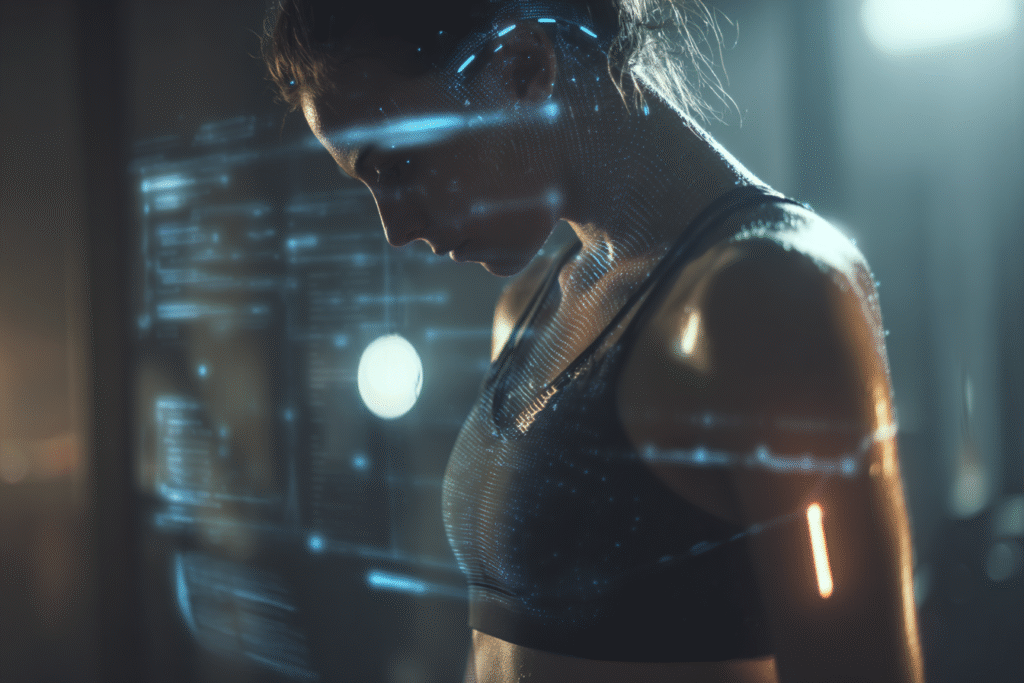
The Future of AI Exercise Optimization
The future of AI in exercise optimization promises even more sophisticated and personalized approaches to fitness and performance enhancement.
Emerging Technologies
Genetic Integration: Future AI systems will likely incorporate genetic analysis to provide truly personalized training recommendations based on individual genetic predispositions to different training stimuli.
Advanced Wearables: Next-generation wearables will provide continuous monitoring of additional biomarkers like blood glucose, lactate, and hormone levels, enabling real-time metabolic optimization.
Virtual Reality Training: AI-powered VR environments will create immersive training experiences that combine entertainment with sophisticated exercise optimization.
Predictive Health and Longevity
Longevity Optimization: AI systems will increasingly focus on exercise protocols that optimize not just performance but long-term health and longevity outcomes.
Preventive Health: AI will become more sophisticated at identifying health risks and designing exercise protocols that specifically address these concerns before they become problems.
Holistic Wellness: Future AI systems will integrate exercise optimization with broader wellness factors including nutrition, sleep, stress management, and mental health.
Your AI Exercise Optimization Action Plan
Implementing AI exercise optimization doesn’t require starting with the most advanced technologies. Here’s a practical roadmap for getting started regardless of your current fitness level or technical expertise.
Immediate Actions (This Week)
- Download and Test AI Fitness Apps: Try 2-3 highly-rated AI fitness apps to find one that matches your goals and preferences. Focus on apps with strong form analysis capabilities.
- Establish Baseline Measurements: Record your current fitness metrics, movement quality, and performance capabilities. This provides the foundation for AI optimization.
- Begin Form Analysis: Use AI form analysis tools for fundamental movements like squats, push-ups, or your primary exercises. Focus on establishing proper movement patterns.
Short-Term Implementation (1-3 Months)
- Master Your Primary Platform: Become proficient with your chosen AI fitness platform’s core features before adding additional technologies.
- Track Consistently: Provide your AI system with consistent, high-quality data through regular use and accurate input.
- Follow AI Recommendations: Implement the AI-generated recommendations consistently to allow the system to learn and adapt to your responses.
Medium-Term Development (3-12 Months)
- Add Physiological Monitoring: Integrate a fitness wearable to provide your AI system with recovery and readiness data.
- Expand Technology Integration: Consider adding smart equipment or additional sensors based on your primary training focus and budget.
- Refine and Optimize: Use the accumulated data to refine your training approach and optimize AI recommendations for your individual responses.
Long-Term Mastery (12+ Months)
- Professional Integration: Consider working with qualified professionals who can help interpret complex AI data and integrate it with human expertise.
- Advanced Technologies: Explore advanced AI technologies like professional movement analysis or comprehensive metabolic monitoring.
- Continuous Evolution: Stay informed about new AI fitness technologies and update your approach as more sophisticated options become available.
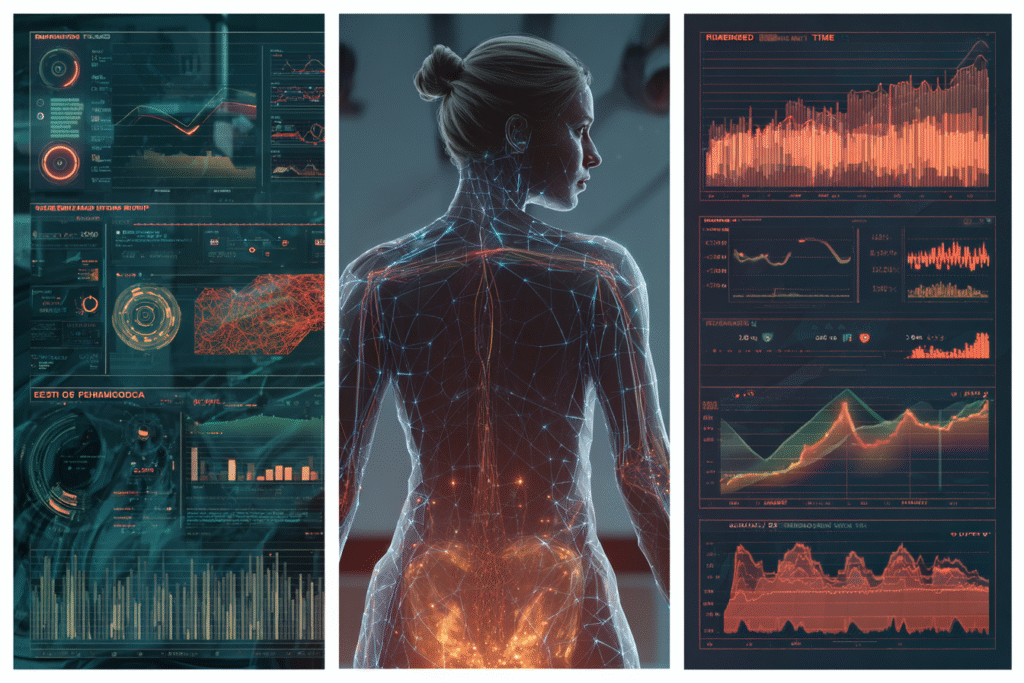
What Happens When Your Workout Thinks For You
Artificial intelligence is fundamentally changing how we approach exercise optimization, offering unprecedented opportunities to maximize training effectiveness, prevent injuries, and achieve fitness goals more efficiently than ever before.
From smartphone-based form analysis to professional-grade predictive modeling, AI technologies are becoming increasingly accessible and powerful.
The key to successful AI exercise optimization lies not in adopting every available technology, but in thoughtfully implementing systems that enhance your training while maintaining the human elements that make exercise enjoyable and sustainable.
Start with accessible technologies, build expertise gradually, and remember that AI is a tool to enhance your training intelligence—not replace your commitment to consistent effort and progressive improvement.
Whether you’re beginning your fitness journey or seeking to optimize elite performance, AI offers tools that can accelerate your progress, reduce injury risk, and help you achieve results that seemed impossible just a few years ago.
The question isn’t whether AI will transform exercise optimization—it’s how quickly you’ll harness these technologies to transform your own training. You’re no longer limited by guesswork, outdated programs, or one-size-fits-all advice.
You’re entering an era where every rep teaches the system—and the system teaches you.
Your smartest training partner is already here—waiting for you to start.
The real question is: are you ready to train smarter?
See you in the next insight.
Comprehensive Medical Disclaimer: The insights, frameworks, and recommendations shared in this article are for educational and informational purposes only. They represent a synthesis of research, technology applications, and personal optimization strategies, not medical advice. Individual health needs vary significantly, and what works for one person may not be appropriate for another. Always consult with qualified healthcare professionals before making any significant changes to your lifestyle, nutrition, exercise routine, supplement regimen, or medical treatments. This content does not replace professional medical diagnosis, treatment, or care. If you have specific health concerns or conditions, seek guidance from licensed healthcare practitioners familiar with your individual circumstances.
References
The references below are organized by study type. Peer-reviewed research provides the primary evidence base, while systematic reviews synthesize findings across multiple studies for broader perspective.
Peer-Reviewed / Academic Sources
- [1] ResearchGate (2024). Design and Adjustment of Optimizing Athletes’ Training Programs Using Machine Learning Algorithms. https://www.researchgate.net/publication/380446445_Design_and_Adjustment_of_Optimizing_Athletes’_Training_Programs_Using_Machine_Learning_Algorithms
- [2] PMC (2024). Diagnostic Applications of AI in Sports: A Comprehensive Review of Injury Risk Prediction Methods. https://pmc.ncbi.nlm.nih.gov/articles/PMC11592714/
- [3] DigitalDefynd (2024). 10 ways AI is being used in Injury Prevention & Rehabilitation. https://digitaldefynd.com/IQ/ai-in-injury-prevention-rehabilitation/
- [4] ResearchGate (2024). AI Fitness Trainer: Dynamic Motion Correction and Real-Time Feedback for Enhancing Self-Managed Workouts. https://www.researchgate.net/publication/382231965_AI_Fitness_Trainer_Dynamic_Motion_Correction_and_Real-Time_Feedback_for_Enhancing_Self-Managed_Workouts
- [5] NESTA Certified (2024). The Future of Fitness: AI-Driven Solutions. https://www.nestacertified.com/the-future-of-fitness-ai-driven-solutions/
Government / Institutional Sources
- [6] Sports Medicine Weekly (2024). AI-Powered Sports Injury Prevention Chicago. https://sportsmedicineweekly.com/blog/ai-powered-injury-prevention-in-sports/
- [7] PMC (2024). Artificial intelligence and Machine Learning approaches in sports: Concepts, applications, challenges, and future perspectives. https://pmc.ncbi.nlm.nih.gov/articles/PMC11215955/
Industry / Technology Sources
- [8] InsightAce Analytic (2025). AI in Fitness and Wellness Market Size & Industry Growth 2030. https://www.insightaceanalytic.com/report/ai-in-fitness-and-wellness-market/2744
- [9] FitBudd (2025). 50+ Fitness App Statistics (Revenue, Market Size, Usage, + More) in 2025. https://www.fitbudd.com/post/50-fitness-app-statistics-revenue-market-size-usage-more-in-2025
- [10] 3DLOOK (2025). Top AI Trends Shaping The Fitness Industry in 2025. https://3dlook.ai/content-hub/ai-in-fitness-industry/
- [11] Virtuagym (2025). Top 5 AI trends for gyms in 2025. https://business.virtuagym.com/blog/ai-trends-gyms/
- [12] Solutelabs (2025). Emerging Trends of AI Fitness Apps in 2025. https://www.solutelabs.com/blog/future-of-fitness
- [13] Virtuagym (2025). Top 15 Technology Fitness Trends in 2025. https://business.virtuagym.com/blog/technology-fitness-trends/
- [14] EGYM (2024). Fitness Meets AI: Transforming the Industry From Within. https://athletechnews.com/fitness-industry-ai/
- [15] Health & Fitness Association (2024). How AI Is Transforming Fitness Apps. https://www.healthandfitness.org/improve-your-club/how-ai-is-transforming-fitness-apps/


